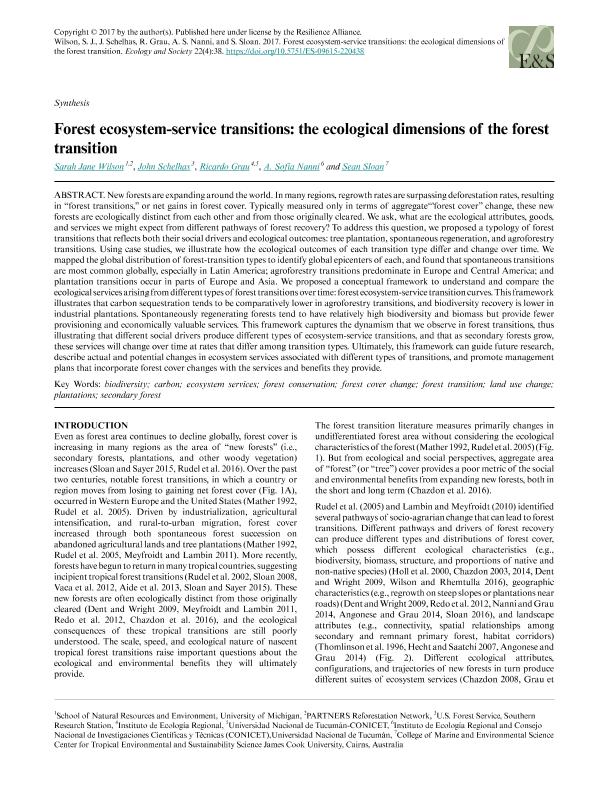Artículo
Forest ecosystem-service transitions: the ecological dimensions of the forest transition
Fecha de publicación:
12/2017
Editorial:
Resilience Alliance
Revista:
Ecology and Society
ISSN:
1708-3087
Idioma:
Inglés
Tipo de recurso:
Artículo publicado
Clasificación temática:
Resumen
New forests are expanding around the world. In many regions, regrowth rates are surpassing deforestation rates, resulting in “forest transitions,” or net gains in forest cover. Typically measured only in terms of aggregate“’forest cover” change, these new forests are ecologically distinct from each other and from those originally cleared. We ask, what are the ecological attributes, goods, and services we might expect from different pathways of forest recovery? To address this question, we proposed a typology of forest transitions that reflects both their social drivers and ecological outcomes: tree plantation, spontaneous regeneration, and agroforestry transitions. Using case studies, we illustrate how the ecological outcomes of each transition type differ and change over time. We mapped the global distribution of forest-transition types to identify global epicenters of each, and found that spontaneous transitions are most common globally, especially in Latin America; agroforestry transitions predominate in Europe and Central America; and plantation transitions occur in parts of Europe and Asia. We proposed a conceptual framework to understand and compare the ecological services arising from different types of forest transitions over time: forest ecosystem-service transition curves. This framework illustrates that carbon sequestration tends to be comparatively lower in agroforestry transitions, and biodiversity recovery is lower in industrial plantations. Spontaneously regenerating forests tend to have relatively high biodiversity and biomass but provide fewer provisioning and economically valuable services. This framework captures the dynamism that we observe in forest transitions, thus illustrating that different social drivers produce different types of ecosystem-service transitions, and that as secondary forests grow, these services will change over time at rates that differ among transition types. Ultimately, this framework can guide future research, describe actual and potential changes in ecosystem services associated with different types of transitions, and promote management plans that incorporate forest cover changes with the services and benefits they provide.
Archivos asociados
Licencia
Identificadores
Colecciones
Articulos(IER)
Articulos de INSTITUTO DE ECOLOGIA REGIONAL
Articulos de INSTITUTO DE ECOLOGIA REGIONAL
Citación
Wilson, Sarah Jane; Schelhas, John; Grau, Hector Ricardo; Nanni, Ana Sofía; Sloan, Sean; Forest ecosystem-service transitions: the ecological dimensions of the forest transition; Resilience Alliance; Ecology and Society; 22; 4; 12-2017; 38
Compartir
Altmétricas
Items relacionados
Mostrando titulos relacionados por título, autor y tema.
-
Carabelli, Francisco Andrés Carabelli ; Lupi, Ana María; Graciano, Corina ; Villagra, Pablo Eugenio (Universidad Nacional de Santiago del Estero. Facultad de Ciencias Forestales, 2019-12)
-
Carabelli, Francisco Andrés Carabelli ; Lupi, Ana María; Graziano, Corina; Villagra, Pablo Eugenio (Universidad Nacional de Santiago del Estero. Facultad de Ciencias Forestales, 2019-12)
-
Mansilla, Paula Romina ; Pancotto, Veronica Andrea ; Moretto, Alicia Susana ; Vrsalovic, Jazmin ; Escobar, Julio Martin ; Oro Castro, Natalia Patricia ; Lencinas, María Vanessa (Sociedad Argentina de Botánica, 2013-09)




